Get Early Access Now
Help Shape the Future of Therapy

The Televagal PhysioCam
Early Access
As an Early Access participant, you’ll receive:
Licenses can be extended by request
- 25 licenses to share with your clients
- Monthly supervision with Deb Dana
- Enhanced personal IT and product support
- Opportunity to influence the development of PhysioCam
To use the PhysioCam during Early Access your client will need a Windows computer and this inexpensive webcam from Amazon. If you also want to use the PhysioCam on the call, you will need the same equipment too. If you’d like to be notified when the Mac OS version becomes available, please sign up here. Further hardware will be supported in future releases.
Early Access Discount: $99 $79 per month

Got Questions?
Feel free to reach out to us with any queries about the PhysioCam—we’re here to help and happy to assist. We look forward to connecting with you!
Aidan whelan, cto
FAQ’s
What is PhysioCam, and how does it work?
The PhysioCam is a novel, non-contact nervous system measurement tool — a “nervous system-ometer”, as we like to say! While many other methods for measuring the nervous system involve invasive contact sensors such as headsets or adhesive electrode pads, PhysioCam uses only the real-time video of a client’s face to evaluate physiology and the changes in their nervous system.
Who can use the PhysioCam?
The PhysioCam is designed for therapists, coaches, and anyone interested in integrating Polyvagal Theory into their work—or who believes their practice could benefit from real-time monitoring of clients’ nervous systems. Even clients and non-practitioners can use the PhysioCam to observe their own nervous system activity.
What does PhysioCam measure?
The PhysioCam observes activity in the vagus nerve, including biomarkers for nervous system states such as stress, relaxation, and emotional regulation — all from video pixels!
How does the PhysioCam help me in my practice?
PhysioCam offers real-time insights into your clients’ nervous system behavior during a consultation, even when it isn’t clearly visible on the outside. This objective, data-oriented supplement to your practice can help you tailor treatments more effectively and track progress in a session.